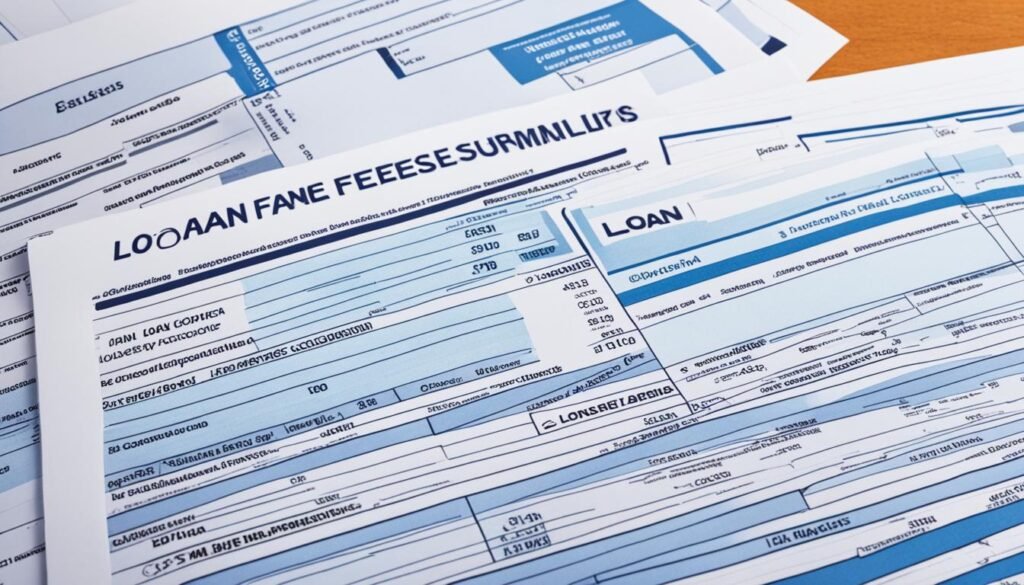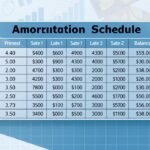Applying for a mortgage can seem overwhelming, but it’s easier with the right steps and knowledge. This guide is here to help you, whether you’re buying your first home or refinancing. We’ll cover the main things you need to know and do during the mortgage application process.
Key Takeaways
- Understand the definition and basics of a mortgage, including fixed-rate and adjustable-rate options.
- Prepare for the mortgage application by reviewing your credit, saving for a down payment, and exploring your financing options.
- Obtain a mortgage pre-approval to strengthen your position as a homebuyer.
- Familiarize yourself with the mortgage application process, including the loan estimate and closing disclosure documents.
- Be aware of the underwriting process and what to expect at the mortgage closing and funding stage.
What is a Mortgage?
A mortgage lets homebuyers buy a property with a loan. When you get a mortgage, you borrow money from a lender like a bank. You promise to pay back the loan, and the lender gets a claim on your property until you’re done paying.
Definition and Explanation of a Mortgage
A mortgage is a loan backed by real estate. You make regular payments to the lender, including interest. This loan helps you buy a home or property, and your property is the loan’s security. If you don’t pay, the lender can take your property and sell it.
Mortgages help people buy homes or investment properties. They let buyers enter the real estate market even if they don’t have all the money upfront. This makes buying property easier for many.
| Key Features of a Mortgage | Explanation |
|---|---|
| Loan Amount | The total amount borrowed to finance the property purchase |
| Interest Rate | The percentage charged by the lender for the use of their money |
| Loan Term | The length of time the borrower has to repay the loan, typically 15 or 30 years |
| Monthly Payments | The regular payments made by the borrower to the lender, including principal and interest |
It’s important to understand mortgages if you want to buy a home or property. Knowing how they work helps borrowers make smart choices and manage the real estate financing process better.
Preparing for a Mortgage Application

Before applying for a mortgage, it’s key to check your credit report and credit score. These are crucial for the lender’s decision. Knowing your credit history helps spot errors and fix them.
First, get your credit report from Experian, Equifax, and TransUnion. Look over each report for mistakes that could hurt your credit rating. If you find errors, quickly correct them with the credit bureau to keep your credit history right.
Then, review your credit score. Scores between 720-850 are best, showing you’re good at borrowing and paying back. If your score is lower, work on it. Pay off debt, lower your credit use, and watch your credit history for changes.
Getting your credit report and score ready helps with your mortgage application. This step boosts your loan terms and shows your financial health.
“Your credit report and credit score are the foundation of a successful mortgage application. Take the time to review and understand them before you start the process.”
Mortgage Pre-approval

Getting a mortgage pre-approval is key for anyone looking to buy a home. It’s a promise from a lender to lend you money to buy a home, under certain conditions. This step helps you know your budget and shows sellers you’re a serious buyer.
To get a mortgage pre-approval, you’ll share personal and financial details with the lender. This includes your credit history, income, assets, and debts. The lender will check this info and give you a pre-approval letter. This letter will show the loan amount, interest rate, and other key details.
A pre-approval has many benefits:
- It shows your buying power and helps you focus on homes within your budget.
- It makes your offer more attractive to sellers, showing you’re a serious buyer.
- It locks in an interest rate, protecting you from rate increases during the buying process.
Pre-qualification is similar but less detailed than pre-approval. While pre-qualification gives a rough idea of what you can borrow, pre-approval is a deeper check of your finances. This makes pre-approval a stronger tool for buying a home.
| Pre-Approval | Pre-Qualification |
|---|---|
| Requires a more extensive review of financial information | Provides a general idea of borrowing capacity |
| Lender performs a hard credit check | Lender performs a soft credit check |
| Offers a more reliable assessment of your financial situation | Less comprehensive than pre-approval |
| Gives you a stronger bargaining position with sellers | Does not carry the same weight as a pre-approval letter |
With a mortgage pre-approval, you’re ready to move forward in the home-buying process. You’ll stand out as a qualified buyer in the market.
Types of Mortgages

When looking for a mortgage, homebuyers have many options. The main types are fixed-rate mortgages and adjustable-rate mortgages (ARMs). It’s important to know the differences to pick the right mortgage loan for you.
Fixed-Rate Mortgages and Adjustable-Rate Mortgages (ARMs)
A fixed-rate mortgage has the same interest rate for the whole loan, usually 15 or 30 years. This means your monthly payments stay the same, giving you stability. On the other hand, an adjustable-rate mortgage (ARM) has a rate that can change over time. ARMs often start low but can go up or down, making them riskier for some people.
Homebuyers can also look at conventional loans or government-backed loans like VA loans, FHA loans, and USDA loans. Each has its own rules and benefits, so it’s smart to compare them.
There are more mortgage types like interest-only loans, hybrid mortgages, and balloon payment loans. Knowing the good and bad of each can help you choose the right one for your financial goals.
The Mortgage Application Process

Applying for a mortgage is a step-by-step process that needs careful planning and documents. You start by filling out a mortgage application and giving documents like pay stubs, tax returns, and bank statements. These documents help the lender check if you can handle the loan.
After you send in your application, the lender will order a property appraisal. This is important because it helps figure out the home’s value. They use this value to calculate the loan-to-value (LTV) ratio, which affects loan approval. At the same time, the lender checks your credit history and score to make sure you’re creditworthy.
The application then goes to the underwriting stage. Here, the lender looks closely at the risk of lending to you. They check your income, assets, debts, and financial health to see if you can pay back the mortgage. You might need to give more documents or explain things, so answer quickly if asked.
| Step | Description |
|---|---|
| 1. Mortgage Application | Complete a formal mortgage application and provide supporting documents such as pay stubs, tax returns, and bank statements. |
| 2. Property Appraisal | The lender will order a property appraisal to determine the home’s market value and assess the loan-to-value (LTV) ratio. |
| 3. Credit Check | The lender will review your credit history and score to ensure you meet the necessary creditworthiness requirements. |
| 4. Underwriting | The lender will thoroughly evaluate your financial profile, including income, assets, and debts, to assess the risk of lending to you. |
The mortgage application process is detailed and takes time, but knowing the steps can make it easier. Being ready with your documents and quick to respond to the lender’s requests can help you apply successfully.
Loan Estimates and Closing Disclosures

Applying for a mortgage is a big step in your financial life. You’ll come across two key documents: the loan estimate and the closing disclosure.
Understanding the Loan Estimate and Closing Disclosure Documents
After you apply for a mortgage, you’ll get a loan estimate within three days. This document lists the loan’s terms, like the interest rate, monthly payment, and closing costs. These costs include origination fees, points, lender fees, and third-party fees. It helps you compare different lenders and choose wisely.
Before the mortgage closing, you’ll get a closing disclosure. This document outlines the final loan costs and terms. It might show changes from the initial loan estimate. Make sure to check it well to know all about your mortgage, including the rate lock and extra fees.
Knowing about the loan estimate and closing disclosure helps you navigate the mortgage process. It lets you make choices that fit your financial plans.
“Carefully reviewing the loan estimate and closing disclosure is essential for ensuring you understand the full cost of your mortgage.”
The Underwriting Process

The underwriting process is key in the mortgage application. Lenders check your financial and personal info to see if they can lend to you. They make sure the loan fits their rules and lowers the chance of you not paying back.
In the underwriting process, underwriters look at several important things, including:
- Credit evaluation: They check your credit history to see if you’re good with credit and likely to pay back the loan.
- Income verification: They make sure you have a steady job, know where your money comes from, and can afford the mortgage payments.
- Debt-to-income ratio: They look at how much debt you have compared to your income. This makes sure you can handle the new mortgage payment.
- Loan-to-value ratio: They check if the property you want to buy is worth the loan amount. This makes sure the home is a good investment.
- Asset verification: They check if you have enough money for a down payment and cash reserves to finish the deal.
- Appraisal: They look at the property’s appraisal to make sure it’s really worth the money and meets their standards.
If the underwriter needs more info or documents, you might have to give them before they decide on your loan approval. This process is set up to help the lender make a smart and informed choice. It protects both you and the lender.
| Underwriting Factor | Description |
|---|---|
| Credit Evaluation | Review of your credit history to determine creditworthiness |
| Income Verification | Verification of your employment status, income sources, and stability |
| Debt-to-Income Ratio | Calculation of your monthly debt payments compared to your monthly income |
| Loan-to-Value Ratio | Assessment of the property value in relation to the loan amount |
| Asset Verification | Verification of your available assets, such as down payment funds and cash reserves |
| Appraisal | Review of the property appraisal to confirm the home’s value and meet lender requirements |
“The underwriting process is the lender’s way of ensuring that the borrower has the financial capacity and creditworthiness to repay the mortgage loan.”
Mortgage Closing and Funding
The final step in the mortgage application process is the mortgage closing. This is where you’ll sign all the necessary paperwork and complete the home purchase. At the closing, you’ll be required to pay your down payment and closing costs, which can range from 2% to 6% of the loan amount.
These closing costs typically include fees for the appraisal, title search, and title insurance, as well as prepaid items like homeowners insurance and property taxes held in escrow. Once all the necessary documents are signed, the lender will fund the loan, and you’ll officially become the owner of your new home.
| Closing Cost Item | Average Cost |
|---|---|
| Appraisal Fee | $300 – $500 |
| Title Insurance | $500 – $1,500 |
| Homeowners Insurance (prepaid) | $500 – $1,000 |
| Property Taxes (prepaid) | Varies by location |
The mortgage closing process can be complex, but with proper preparation and understanding of the closing costs, you can ensure a smooth transition into homeownership.
Also Read : Fixed-Rate vs. Variable-Rate Mortgages: A Comparative Analysis
Conclusion
The mortgage process might seem complex, but you can handle it with the right prep and knowledge. Start by checking your credit and getting pre-approved. Then, look into different loan options and the closing process. Each step is key to getting you closer to owning a home.
Knowing about the mortgage process, home buying, and financial planning helps you make smart choices. With the right advice from experts, you can move forward on your path to homeownership.
Whether it’s your first home or you’re an experienced investor, getting the right mortgage is exciting and rewarding. Stay focused on your goals and embrace the process. You’ll soon find yourself enjoying the financial stability and personal fulfillment of owning your own home.
FAQs
Q: How do I apply for a mortgage?
A: To apply for a mortgage, you need to gather your financial documents such as pay stubs, tax returns, and bank statements. Then, you can contact a lender or mortgage broker to start the application process.
Q: What is a mortgage rate?
A: A mortgage rate is the interest charged by a lender for borrowing money to buy a home. It can be fixed or adjustable, and it affects your monthly mortgage payment.
Q: How can I find the best mortgage rate?
A: You can shop around with different lenders to compare mortgage rates and terms. Using a mortgage calculator can help you estimate your monthly mortgage payment and find the best deal.
Q: What is a monthly mortgage payment?
A: A monthly mortgage payment is the amount you pay each month to your lender to repay your home loan. It typically includes principal, interest, taxes, and insurance.
Q: What is mortgage insurance?
A: Mortgage insurance is a policy that protects the lender if you default on your loan. It is usually required for borrowers with a down payment of less than 20% of the home’s value.
Q: How does the mortgage loan process work?
A: The mortgage loan process involves applying for a loan, getting pre-approved, selecting a home, getting the home appraised, and closing the deal. Your lender will guide you through each step.
Q: What is amortization in relation to a mortgage?
A: Amortization is the process of paying off a mortgage over time through regular monthly payments. It includes both principal and interest, with the majority of early payments going towards interest.
Source Links
- https://www.bankofamerica.com/mortgage/learn/how-to-apply-for-a-mortgage/
- https://www.fdic.gov/resources/consumers/consumer-news/2022-06-17.html
- https://www.nerdwallet.com/article/mortgages/how-to-apply-for-a-mortgage






